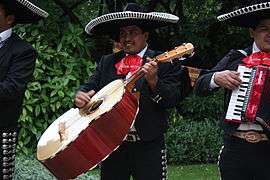Guitarrón mexicano



The guitarrón mexicano (the Spanish name of a "big Mexican guitar", the suffix -ón being a Spanish augmentative) or Mexican guitarrón is a very large, deep-bodied Mexican six-string acoustic bass played traditionally in Mariachi groups. Although similar to the guitar, it is not a derivative of that instrument, but was independently developed from the sixteenth-century Spanish bajo de uña ("fingernail[-plucked] bass"). Because its great size gives it volume, it does not require electric amplification for performances in small venues. The guitarrón is fretless with heavy gauge strings, most commonly nylon for the high three and wound metal for the low three. The guitarrón is usually played by doubling notes at the octave, a practice facilitated by the standard guitarrón tuning A1 D2 G2 C3 E3 A2.
The guitarrón was the inspiration behind Ernie Ball's development of the first modern acoustic bass guitar, released on the market in 1972.[1]
Use
Traditional uses
The guitarrón is used in Mexican Mariachi groups, which usually consist of at least two violins, two trumpets, one Spanish guitar, and a vihuela (a high-pitched, five-string guitar-type instrument), and the guitarrón. A strap is usually used to keep the instrument up and playable. The guitarrón is the principal rhythm instrument in the mariachi group, and keeps the other instruments together on beat. Guitarrón players need good left-hand strength to stop the heavy strings of the instrument and a strong right hand, specifically the index, middle finger, and thumb, to pluck two of the strings (usually a metal and a nylon string).
Non-traditional uses
- Mexican composer Julián Carrillo adapted the guitarrón for microtonal music by adding frets to enable it to play eighths of a tone. He scored for this instrument, under the name octavina, in several compositions, most notably the Preludio a Colón (1922).
- The guitarrón is played by Roy Estrada on the 1966 Mothers of Invention album Freak Out!.
- Randy Meisner of the Eagles also plays the guitarrón on the track "New Kid In Town" from the album Hotel California (1976; in the credits the name of the instrument is anglicized to "guitarone").[2]
- One American player using the guitarrón in a non-traditional context is Aaron Goldsmith, formerly of the New York-based multicultural acoustic ensemble Luminescent Orchestrii; he uses a modified guitarrón with an elongated neck that allows him to play melodically.
- Played by Simon Edwards, the guitarrón was a defining element of the 1980s British folk-pop band Fairground Attraction. In addition, Edwards plays the guitarrón on the Talk Talk album Spirit of Eden (labelled "Mexican bass" in liner notes.)
Design
The back of the guitarrón is made of two pieces of wood that are set at an angle making the back shaped like a shallow letter V. This design feature increases the depth and overall size of the instrument.
See also
References
- ↑ "Ernie Ball Music Man Company History". Music-man.com. Archived from the original on 2013-03-27. Retrieved 2013-03-23.
- ↑ "Liner Notes – Hotel California (The Eagles)". Glennfreyonline.com. Retrieved 2013-03-23.
External links
- Music sheets for guitarrón and other mariachi instruments http://musicaldots.com/